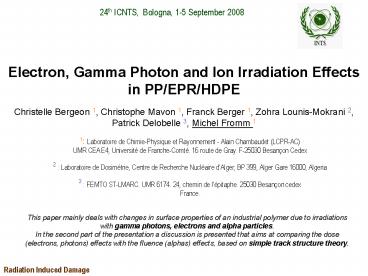Prsentation PowerPoint - PowerPoint PPT Presentation
1 / 20
Title:
Prsentation PowerPoint
Description:
with gamma photons, electrons and alpha particles. ... Alphas : 1011 to 1016 He .cm-2, 400 keV, Under vacuum (Ion implantation, Lyon, France) ... – PowerPoint PPT presentation
Number of Views:89
Avg rating:3.0/5.0
Title: Prsentation PowerPoint
1
Electron, Gamma Photon and Ion Irradiation
Effects in PP/EPR/HDPE Christelle Bergeon 1,
Christophe Mavon 1, Franck Berger 1, Zohra
Lounis-Mokrani 2, Patrick Delobelle 3, Michel
Fromm 1
1 Laboratoire de Chimie-Physique et Rayonnement
- Alain Chambaudet (LCPR-AC)UMR CEA E4,
Université de Franche-Comté. 16 route de Gray.
F-25030 Besançon Cedex 2 Laboratoire de
Dosimétrie, Centre de Recherche Nucléaire
dAlger, BP 399, Alger Gare 16000, Algeria 3
FEMTO ST-LMARC. UMR 6174. 24, chemin de
lépitaphe. 25030 Besançon cedexFrance.
This paper mainly deals with changes in surface
properties of an industrial polymer due to
irradiations with gamma photons, electrons and
alpha particles. In the second part of the
presentation a discussion is presented that aims
at comparing the dose (electrons, photons)
effects with the fluence (alphas) effects, based
on simple track structure theory.
Radiation Induced Damage
2
The Polymer Under Study PP / EPR / HDPE
Plastics have become an important material for
industrial applications, particularly in the
automobile sector. Nowadays, plastics make up on
average more than 15 of a vehicles weight.
Polypropylene is the most commonly used polymer
base. This material is the object of this study.
Plastic parts are usually coated with paint
and/or varnish. Workers in the industry have been
trying to improve the coatings adherence
properties for years. They often try to improve
adherence by using a flaming treatment or a
plasma technology.
What are the effects of ionizing radiations on PP
/ EPR / HDPE surface and bulk properties ?
3
The Polymer Under Study PP / EPR / HDPE
is a ternary blend isotactic polypropylene /
ethylene-propylene rubber / high density
polyethylene
Scanning Electron Microscopy of the PP/EPR
chemically etched in potassium permanganate in
an acid medium
Brandon JP, Ph-D Thesis, University of Besançon,
N 245, 1991.
4
Irradiations
Electrons 10 to 106 Gy, 2 MeV, In air (Van de
Graaf accelerator, Aerial, Strasbourg,
France) Gammas 10 to 106 Gy, 1.17 et 1.33 MeV,
In air (60Co source, Alger, Algeria ) Alphas
1011 to 1016 He.cm-2, 400 keV, Under vacuum
(Ion implantation, Lyon, France)
The samples are exposed to electrons and gamma
photons in air, as for the alpha particles,
irradiation is performed under vacuum !
Electron and gamma photon irradiations can be
considered as uniform which is not the case for
alpha particles (track structure and dependance
on the fluence) The depth at which the incomming
particles deposit their energy is very different
as well as their stopping power
Oxygenation
Radiation Quality
5
Analytical methods
Irradiated samples have been analysed by means of
- FT-IR / ATR (Functional groups)
- Contact angle (Surface energy, polarity,
dispertion, ) - Nano-Indentation (Youngs modulus Hardness)
Surface properties
- Differential Scanning Calorimetry (Melting
enthalpy temperature) - Swelling (Swelling ratio and soluble fraction)
Bulk properties
6
Results Surface chemical modifications
FT-IR/ATR spectroscopy
1709 cm-1 Carbonyl bond
Gedde et al., J. Appl. Polym. 1990
O2
Vacuum
1630 cm-1 vinylic function
A. Chapiro, NIM B. 1988
7
Results (alphas only) Surface modifications
Contact angle
Surface free energy versus fluence
Untreated
There is a correlation between the increase in
surface free energy and the loss of hydrogen
(vinylic bond formation).
8
Results Electrons and photons Hardness
Youngs Modulus. Whatever electrons or photons
were used the results obtained are similar when
compared as a function of Dose
9
Results Nano-indentation curves for alpha
electron - irradiated samples.
The visco-elastic behaviour does not remain after
irradiation
The visco-elastic behaviour remains
10
Results Swelling for gamma electron
-irradiated samples.
Immersion in 1,2 -dichlorobenzene after
irradiation at an electron dose of 9 . 105
Gy. We observe the crosslinking effect.
11
Results Swelling in hexane for gamma
electron -irradiated samples.
12
Results Differential Scanning Calorimetry
Melting peaks for the two main components of the
compound, i.e. PP and HDPE
13
Results Differential Scanning Calorimetry
14
Comparison
15
Dose Fluence
For the ion irradiation, the track overlapping
can explain most of the observed effects
See the work by Yamauchi
But, is there a way to transform a dose into a
fluence or reciprocally ?
16
Dose - Fluence Relation ?
Equivalent Dose Calculation for ? 5 .1013
He.cm-2 In Polyethylene
With electrons and gammas in air, we find D
105 Gy
17
Dose - Fluence Relation ?
The latent track
Matlab calculation based on
18
Dose - Fluence Relation ?
Dose inside the latent track
? 5 .1013 He.cm-2
To be compared with D 105 Gy !
19
Conclusions
20
(No Transcript)































